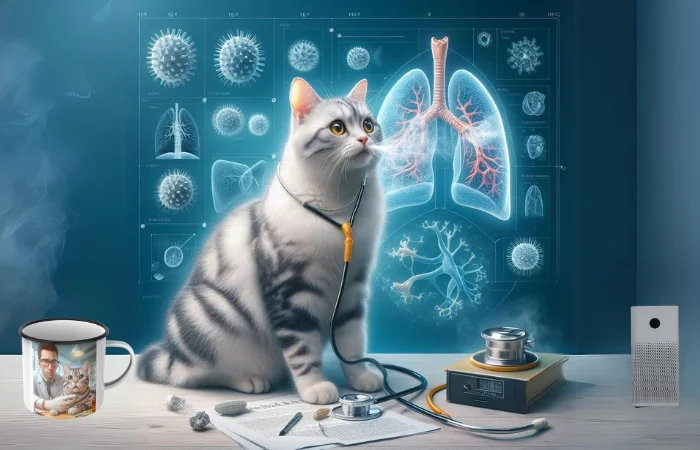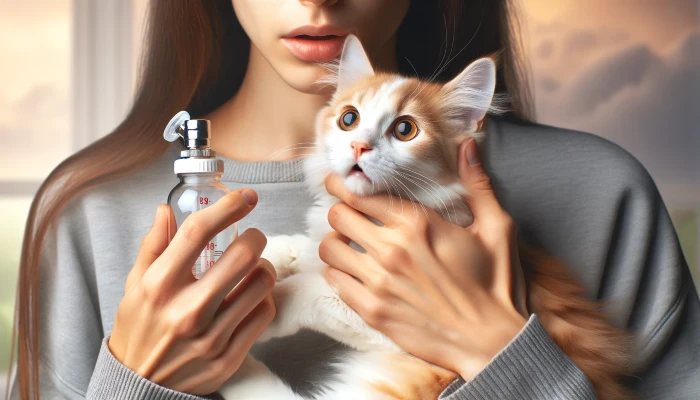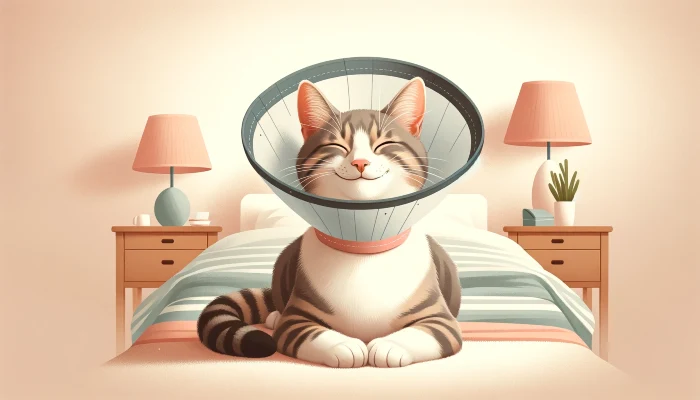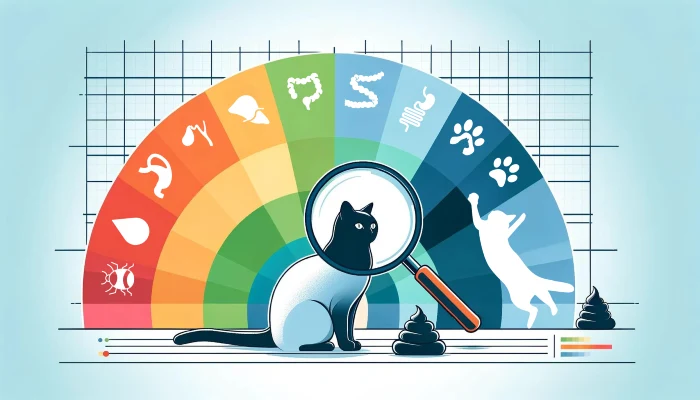Unraveling the Wheeze: What It Means for Your Feline Friend
When your cat starts wheezing, it’s more than just a peculiar sound—it’s a red flag that your furry family member might be facing some health challenges. Wheezing, with its distinctive soft huff or gentle whistle, is a clue that something’s not quite right in your cat’s respiratory system. Understanding why your cat is wheezing is the first step toward addressing any potential issues, whether they’re minor or indicative of something more serious.
Catching these signs early and figuring out the cause—be it asthma, an allergic reaction, or a respiratory infection—is vital. It’s not just about soothing an occasional wheeze; it’s about diving into the root of the problem and ensuring your cat’s long-term health. Quick action and a visit to the vet can make all the difference, turning concern into peace of mind for both you and your whiskered companion.
Key Insights:
- Spotting the Signs: Learn to recognize when and why your cat wheezes.
- Prompt Vet Visits: Understand the urgency of veterinary intervention for wheezing.
- Protecting Their Health: Quick responses are key to your cat’s well-being.
Let’s delve deeper into how recognizing, diagnosing, and treating your cat’s wheezing can lead to a happier, healthier life for your beloved pet.
Decoding Wheezing: A Sign to Act in Cats
Wheezing in cats isn’t just a quirky noise—it’s a clear signal that your cat needs attention. This sound, often a mix of whistling and huffing during breathing, can see your cat extending its neck or hunching its shoulders in an effort to breathe more easily. Such behaviors indicate not merely discomfort, but potentially could be a very serious health issue that requires investigation.
From the mild—like a hairball, dust mites or allergic reactions—to the more severe, such as feline asthma or respiratory infections, wheezing is a symptom that demands swift action to ensure the well-being of our feline companions.
Finding the Cause of Your Cat's Wheeze: My Experience
When my cat’s wheezing didn’t stop, I knew we had to dive deeper. The vet’s approach was practical and focused. The visit started with a physical check, where they listened to my cat’s lungs and heart, ruling out or pointing towards issues like respiratory infections or allergic reactions.
Blood tests were next on the list, helping to identify any underlying infections, allergies, or signs of heartworm disease that could be making my cat wheeze. Then, chest x-rays offered a clear view inside my cat’s chest, checking for asthma, foreign objects, or even tumors.
The process was all about getting to the root of the problem without unnecessary steps. With these insights, we could create a treatment plan that addressed my cat’s specific needs, aiming for a quick return to health and happiness.
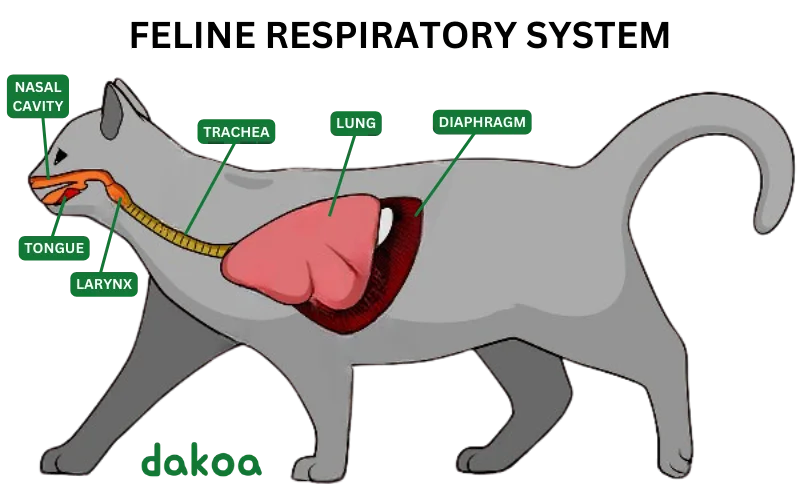
Common Causes of Cat Wheezing
Understanding the triggers behind your cat’s wheezing is crucial to addressing their needs effectively. Here’s a closer look at some of the primary culprits:
- Feline Asthma: Much like human asthma, this condition can cause significant difficulty breathing in cats, manifesting as wheezing or a distinct whistling sound. An asthma attack in cats is a serious event that requires immediate veterinary care.
- Respiratory Infections: These can complicate your cat’s health, leading to symptoms such as lethargy, decreased appetite, and, of course, wheezing. They can be caused by either a bacteria or fungus. Respiratory infections demand prompt medical attention to prevent worsening.
- Foreign Objects: Occasionally, cats inhale or ingest foreign bodies that can obstruct their airways, leading to wheezing. This scenario necessitates a quick response to remove the obstruction and restore normal breathing.
- Heartworm Disease: A severe and often overlooked cause of wheezing, heartworms can lead to serious respiratory distress and even heart failure in cats. Early detection and treatment are key to managing this condition.
By keeping an eye out for these common causes and understanding the potential severity behind each, pet owners can take proactive steps towards securing their cat’s health and happiness. Ensuring your cat receives regular check-ups, stays at a healthy weight, and lives in a clean, smoke-free environment can help minimize the risk of wheezing-related issues. Remember, a prompt visit to the vet can provide an accurate diagnosis and an appropriate treatment plan, offering peace of mind for you and a healthier life for your cat.
Pinpointing the Cause: How Vets Diagnose Cat Wheezing
When the soft whispers of wheezing persisted from my cat, it was clear that a deeper investigation was needed to uncover the root cause. The journey to diagnosis began with a meticulous vet visit, emphasizing the importance of a detailed physical examination. Utilizing a stethoscope, the vet meticulously listened to my cat’s breaths, searching for any signs of blockage or irritation that could be contributing to the wheezing.
The examination extended beyond just listening; blood tests played a pivotal role in identifying or ruling out potential allergies or infections that could be distressing my furry companion. But the diagnostic process didn’t stop there—chest x-rays became the window through which the vet could glimpse inside my cat’s chest cavity. These images were invaluable, revealing critical clues whether asthma, tumors, or sneaky foreign objects were to blame.
This step-by-step approach is necessary for an accurate diagnosis and effective treatment.
The vet’s dedication to precision, rather than guesswork, ensured a treatment plan that wasn’t just a shot in the dark but a targeted strategy tailored to my cat’s unique health profile. This thorough diagnostic process, from physical exams to blood tests and chest x-rays, is fundamental for any pet owner navigating the complexities of their cat’s wheezing, aiming for a path that leads to recovery and well-being.
Hear What A Cat With Asthma Sounds Like
Veterinary Diagnostic Steps for Cat Wheezing
When a cat presents with wheezing, veterinarians follow a systematic approach to diagnose the underlying cause. Here’s a detailed look at the typical procedures, what they involve, and the average cost to the pet owner:
- Physical Examination:
- What it involves: The vet conducts a thorough physical assessment, including listening to the cat’s lungs and heart with a stethoscope, checking for signs of respiratory distress, and observing the cat’s general appearance and behavior.
- Average cost: $50 – $100
- Blood Tests:
- What it involves: Blood work is performed to check for signs of infection, inflammation, or other conditions that could be causing or contributing to the wheezing, such as allergies or heartworm disease.
- Average cost: $80 – $200
- Chest X-rays:
- What it involves: X-rays of the chest are taken to look for any abnormalities in the lungs, heart, and airways that might be causing the wheezing, such as asthma, foreign objects, or tumors.
- Average cost: $100 – $250
- Diagnostic Tests for Specific Conditions: Depending on initial findings, further tests may be necessary to pinpoint the cause:
- Feline Asthma: Allergic bronchitis or asthma might require specific tests, including bronchoalveolar lavage or airway sampling.
- Heartworm Disease: A heartworm test may be conducted if heartworms are a suspected cause of the wheezing.
- Foreign Bodies or Tumors: Additional imaging, like CT scans, might be needed in severe cases or if initial tests are inconclusive.
- Allergy Testing:
- What it involves: If an allergic reaction is suspected, allergy testing may be done to identify specific triggers, such as dust mites or pollen.
- Average cost: $200 – $300
-
- Bronchoscopy:
-
-
- What it involves: In cases where respiratory tract obstruction or chronic inflammation is suspected, a bronchoscopy allows direct visualization of the airways and collection of samples.
- Average cost: $400 – $600
-

The costs can vary based on the location, the complexity of the case, and the specific tests required. It’s always a good idea for pet owners to discuss the potential diagnostic path and associated costs with their vet. Early detection and an accurate diagnosis of your pet’s condition are crucial for effective treatment and can significantly improve the quality of life for your cat, ensuring they lead a healthy, happy life despite any respiratory challenges.
Managing and Treating Your Cat's Wheezing
The treatment for a wheezing cat depends on what’s causing the issue. For cats with asthma, corticosteroid medications often help reduce airway inflammation. These can be administered through an aerosol chamber, similar to treatments for people with asthma, helping your cat breathe easier.
If a bacterial infection is to blame, antibiotics are usually the go-to solution, addressing the infection directly. But it’s not all about medication. The environment plays a huge role in managing a cat’s respiratory health. For allergies triggered by dust mites or smoke, something as simple as switching to a different cat litter or keeping the air clean can make a big difference.
Effective treatment requires a partnership between pet owners and vets, focusing on both medical intervention and lifestyle adjustments to ensure our cats live comfortably despite their respiratory issues. Whether it’s dealing with severe breathing problems or maintaining a healthy weight in an asthmatic cat, a tailored approach is key.
Common and Uncommon Treatments for Cat Wheezing
- Corticosteroid Medications: For asthma, to reduce inflammation.
- Average cost: $20 – $100 per month
- Aerosol Chamber: Used with inhalers to treat asthma.
- Average cost: $50 – $120
- Antibiotics: For bacterial infections.
- Average cost: $15 – $50
- Environmental Changes: Such as dust-free cat litter or air purifiers.
- Average cost: Cat litter $10 – $30 per month, Air purifiers $50 – $250
- Oxygen Therapy: For severe respiratory distress.
- Average cost: $100 – $200 per session
- Allergy Testing and Management: Identifying triggers like dust mites or pollen.
- Average cost: $200 – $300 for testing
- Dietary Adjustments: Keeping an asthmatic cat at a healthy weight.
- Cost varies by diet plan and food type
- Surgery: In rare cases, like removing foreign objects or tumors.
- Average cost: $500 – $2,000+
- Corticosteroid Medications: For asthma, to reduce inflammation.
A comprehensive plan, blending medical treatments with environmental and lifestyle changes, offers the best path to relief for wheezing cats, aiming for a happy and healthy life.
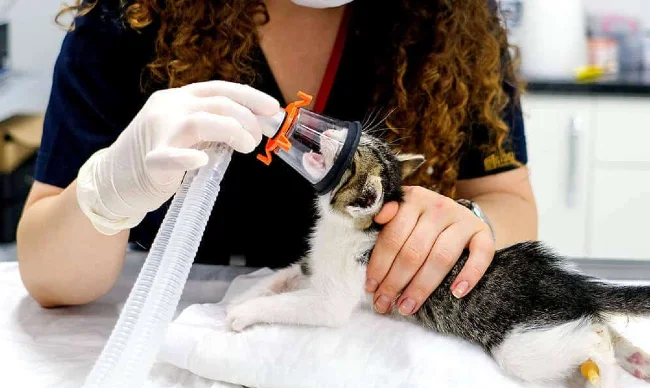
Recognizing Emergency Symptoms in Wheezing Cats
Keeping a close eye on your cat for any signs of serious respiratory trouble is key. And remember, cats are alpha predators, hiding their symptoms and discomfort is woven into their DNA, so you’ll need to pay close attention!
Look out for rapid or open-mouth breathing—these are clear signals your cat is fighting for air. Such symptoms can quickly turn into an emergency, needing immediate action. Meaning, head to the vet right now!
An almost more alarming sign is if your cat’s gums turn blue. This is a condition known as cyanosis, which indicates a severe lack of oxygen. You need to move fast because timing is critical, and your feline requires medical help right away.
Symptoms like these, along with wheezing, might hint at serious conditions like heart problems, respiratory infections, or asthma attacks, all of which can have a major impact on your cat’s lung and airway health, and could even lead to heart failure if ignored.
Recognizing these emergency indicators and acting swiftly can, very literally, be the difference between life and death for your cat. How fast you act can also be the difference between a manageable health problem and a critical, life-threatening situation. Always reach out to your vet immediately for a thorough evaluation and to figure out the best course of action. Prompt veterinary intervention can significantly improve your cat’s health, helping them return to their happy, active self.
Keeping Your Cat Happy and Healthy: Prevention Tips
When your cat starts wheezing, it’s a wake-up call to take preventive action. Here are practical steps to help keep your feline friend breathing easily and minimize the risk of respiratory issues:
- Maintain a Clean Living Space
- Keep your home free from dust mites and other allergens to lessen the chance of allergic reactions. Regular cleaning and vacuuming can make a significant difference in your cat’s health.
- Avoid Smoking Around Your Cat
- Smoke can worsen or even trigger respiratory problems. This is especially crucial in homes with asthmatic cats, as consistent cigarette smoke can severely affect a cat’s lungs.
- Ensure Regular Vet Visits
- Routine check-ups can catch underlying health issues early, from allergies to heart conditions or even lung cancer. Early detection can lead to more effective treatment, giving your cat the best shot at a long, happy life.
- Consider Air Purifiers
- To further reduce airborne allergens and improve your cat’s environment, think about using air purifiers in areas where your cat spends a lot of time.
- Choose Hypoallergenic Bedding and Cat Litter
- Choosing dust-free cat litter and hypoallergenic bedding can also help prevent respiratory issues by reducing irritants in your cat’s immediate surroundings.
- Keep Your Cat at a Healthy Weight
- Overweight cats are at a higher risk of developing respiratory problems. A balanced diet and regular exercise are key to maintaining a healthy weight.
By adopting these preventative measures, you’re not just addressing wheezing; you’re also paving the way for a healthier lifestyle for your cat. It’s about creating a safe, clean, and nurturing environment that allows them to thrive. Your proactive care can make all the difference, ensuring a future filled with joy and companionship for you and your whiskered friend.
Charting a Path to Health for Wheezing Cats
Discovering my cat’s wheeze turned my world upside down. I dove headfirst into every possible cause, from simple irritants like dust mites to more serious concerns like heart disease and lung cancer. This journey taught me one crucial lesson: Being informed and acting quickly makes all the difference.
Working with my vet, we tackled everything from blood tests to chest x-rays to pinpoint the exact problem.
There were scary moments, like when rapid and open-mouth breathing rushed us to the emergency vet, but these challenges emphasized the need for a personalized treatment plan.
Making my home a haven free of allergens wasn’t just for show; it was a critical step in caring for my asthmatic cat and a reminder of the importance of a clean environment for any pet with respiratory issues.
This experience transformed me into a champion of preventive measures—avoiding smoke, maintaining a healthy weight for my cat, and more. These steps weren’t just cautionary; they were essential in paving the way to a healthier future.
Through it all, I learned that managing my cat’s wheezing goes beyond just treating symptoms. It’s about tackling the underlying issues head-on, offering a chance for a better quality of life. My journey with my cat’s wheezing has been eye-opening, reinforcing that with dedication and proactive care, a healthy, joyful life with our feline companions is well within reach.








